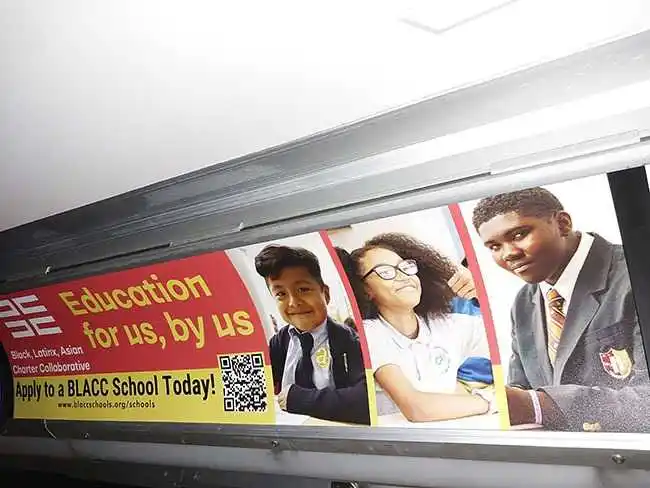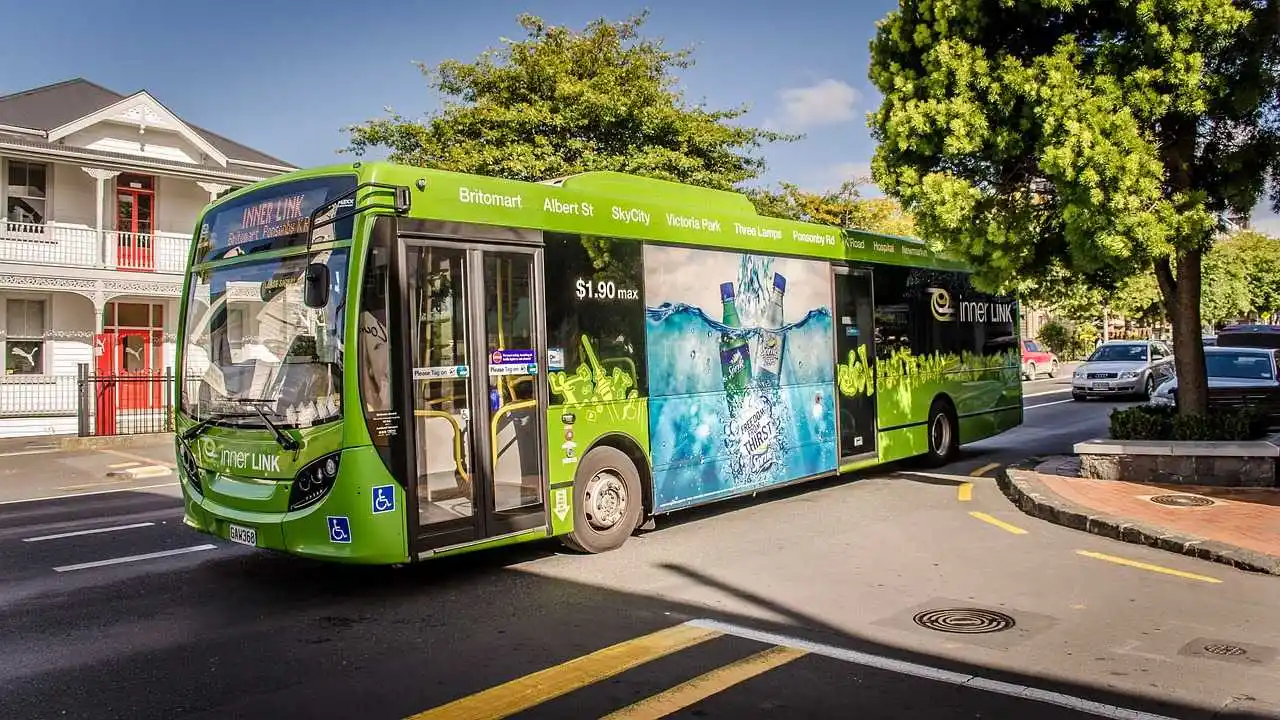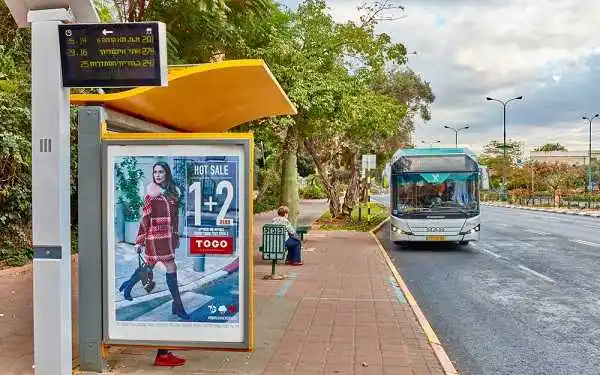Types of Bus Ads
There are 2 Major types of Bus Advertisements:
Poster
![bus-ads.jpg]()
Posters are displayed inside the bus generally in the spaces above the window which grabs attention when commuting. This ad gives the audience enough time to read the advertisement and take action if required. This Ads Space is generally used by local businesses like coaching institutes, and more.
Bus Wrap
![collective-435584_1280.jpg]()
Bus Wrap are advertisements which are outside a bus like a poster in space below the window, rear window, or an ad which fully wraps the bus. This helps brands grab the attention of people commuting along the same route as the bus.
Bus Shelter Advertising
![bus-station-ads.png]()
These are Advertisements displayed on the bus stop targeting commuters waiting for the bus. Even though it's not a moving advertisement, it may still be as impactful as poster bus ads.
7 Advantages of Bus Advertising
Bus advertising offers numerous benefits, making it a highly effective marketing strategy for businesses. Here are some of the best benefits:
1. Wide Reach and High Visibility
- Mobile Exposure: Buses travel through various parts of the city, including busy streets, residential areas, and commercial districts, reaching a diverse audience.
- Repeated Exposure: Commuters and pedestrians see bus ads multiple times as they go about their daily routines, reinforcing brand awareness.
2. Cost-Effective
- Lower Cost Per Impression: Compared to other forms of outdoor advertising, bus ads often provide a lower cost per impression, making them a cost-effective option for reaching a broad audience.
- Extended Exposure Time: Ads on buses are visible for extended periods, often for several weeks or months, providing continuous exposure without additional costs.
3. Targeted Geographic Coverage
- Route-Specific Targeting: Businesses can choose specific bus routes that pass through areas where their target demographic is most likely to be found.
- Localized Marketing: Ideal for local businesses looking to attract customers from specific neighborhoods or districts.
4. High Frequency and Reach
- Consistent Visibility: Buses operate daily and frequently, ensuring that the advertisement is seen consistently over time.
- High Traffic Areas: Buses often travel through high traffic areas, ensuring maximum visibility to a large number of people.
5. Creative Flexibility
- Large Ad Space: The large surface area of buses allows for creative and eye-catching designs that can include detailed visuals and messages.
- Variety of Formats: Options include full bus wraps, side panels, rear ads, and interior ads, providing multiple ways to display messages.
6. Non-Intrusive Advertising
- Passive Engagement: Unlike digital ads that can be intrusive, bus ads are passive and integrated into the environment, making them more acceptable and less likely to be ignored.
- Positive Public Perception: Outdoor advertising, including bus ads, is generally viewed more favorably by the public compared to online pop-ups and banner ads.
7. Increased Brand Awareness
- Memorable Impact: The large, colorful ads are hard to miss, creating a strong visual impact that helps in brand recall and recognition.
- Broad Demographic Reach: Buses reach a wide demographic, including different age groups, income levels, and backgrounds, broadening the potential customer base.
Bus advertising's combination of wide reach, cost-effectiveness, and creative potential makes it an attractive option for businesses looking to enhance their visibility and brand presence in a dynamic and engaging way.
Bus Advertising Strategy
Creating an effective bus advertising strategy involves several key steps to ensure that your campaign reaches the right audience, conveys the intended message, and achieves your marketing goals. Here's a comprehensive strategy:
1. Define Your Objectives
Before getting started with Bus advertising, it's necessary to define what you want to achieve from your ad. The objective of the website can be anything:
- Brand awareness
- Getting traffic to your website
- get more store visits
- Driving online sales
- and more
Once you have defined the objectives, it will be base of your overall strategy.
2. Identify Your Target Audience
You must know who you want to target based on various factors like:
- Age
- Gender
- Income
- Location
- Interest
- Education
- Occupation
- and more
With this information, you can create a few buyer personas which define your target audience. It will help you create further strategies like what messages to put, which location to run the bus ad and more.
3. Budget Planning
Budget allocation is one of the most important things to think about before you get started. Firstly, you must have an idea of how much you have to spend on various operations like:
- Cost of Design
- Poster/ Wrap Production Cost
- Placement Cost
Along with the cost, you must calculate the potential return of Ad Spent (ROI) to check if the ad is profitable or not.
4. Creative Ad
Now as per your defined goal, audience and budget, you have to create a creative print which helps your message reach the right audience effectively. Below are a few ways you can create a creative design:
- Eye-Catching Visuals: Design ads that are visually appealing and can be easily read and understood from a distance. Use bold colours, large fonts, and high-contrast images.
- Clear Message: Keep the message simple and direct. Include a strong call-to-action (CTA) and ensure your brand logo and contact information are prominently displayed.
- Consistency: Ensure consistency with your overall brand image and other marketing materials.
- Feature Celebrity in Your Ads: Celebrity is a face with which people resonate and can give your ad more public attention compared to a faceless animation. We can help you connect with top Bollywood Celebrities, Marathi, Punjabi, Gujarati, etc stars. We'll help with end-to-end service from helping choose the right celebrity for your ad, to the creation of the ad. Click the below button to contact us:
![button_create-bus-ads-featuring-celebrity.png]()
5. Ad Format Selection
While creating the design, you have to create as per the below ad format you are going to use:
- Full Bus Wraps: For maximum impact, consider full bus wraps that cover the entire bus. This option provides the largest and most eye-catching space.
- Side Panels: These are visible to pedestrians and drivers from the side of the bus.
- Rear Ads: These are visible to traffic following the bus and can be very effective in high-traffic areas.
- Interior Ads: Target passengers inside the bus with posters and digital screens.
6. Route Selection
Selection of route is necessary especially if your goal is to only get an audience from a specific region like an education institute, Clinic, or Salon.
7. Implementation and Deployment
Once everything is decided, you can contact agencies which help your ad get places the buses at the preferred location.
8. Monitoring and Adjustment
- Track Performance: Use tracking methods such as unique URLs, QR codes, and dedicated phone numbers to measure responses and engagement.
- Feedback Collection: Gather feedback from customers and the general public to gauge the campaign's impact.
- Adjustments: Based on performance data and feedback, make necessary adjustments to optimize the campaign.
9. Complementary Marketing Activities
- Integrated Campaigns: Combine bus advertising with other marketing channels such as social media, email marketing, and events to reinforce your message.
- Promotions and Offers: Include special promotions or discounts to entice potential customers to take action.
10. Post-Campaign Analysis
After the campaign ends, analyze the data to determine if the objectives were met. Identify what worked well and what didn't to improve future campaigns.
By following these steps, you can create a comprehensive and effective bus advertising strategy that maximizes your campaign's impact and helps achieve your marketing goals.
![birthday occasion]() Birthday Gifts
Birthday Gifts
![anniversary occasion]() Anniversary Gifts
Anniversary Gifts
![women]() Women
Women
![men]() Men
Men
![Couples]() Couples
Couples
![Couples]() Wedding Gifts
Wedding Gifts

 Birthday Gifts
Birthday Gifts
 Women
Women
 Men
Men
 Anniversary Gifts
Anniversary Gifts
 Wedding Gifts
Wedding Gifts




 We now support international payments
We now support international payments
